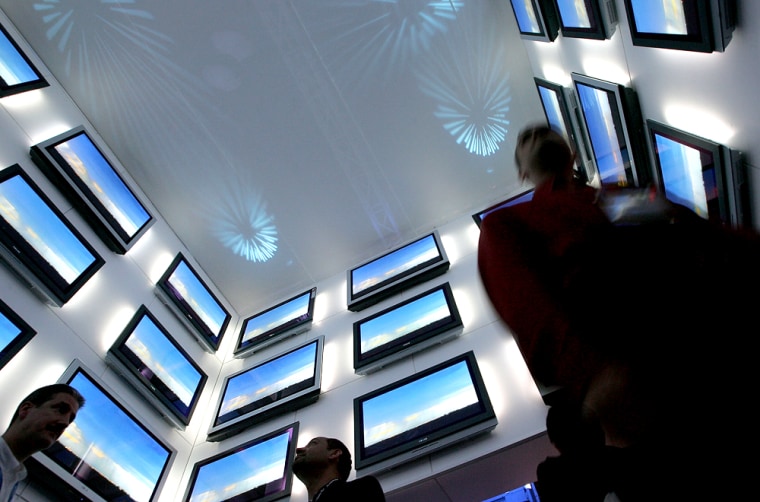I don’t care if it’s high-def, low-def or no-def, but please, Santa, make my new television a flat-panel.
That could be the Christmas wish for millions of American consumers as televisions have become a hot holiday sales item, driven by rapidly falling prices for flat-panel models.
Despite a morass of acronyms, jargon and competing technologies, industry executives say consumers are overcoming any confusion and boiling down their desire to a single, simple demand: Make it flat.
“I think that there has really been an inflection point in the market, and that inflection point has been new price points on flat-panel television sets that have really excited customers," said Kevin Winneroski, television merchandise leader for Best Buy. "Many consumers may still have the lingering impression that to buy a flat panel requires a $10,000 investment, and it’s just not that way."
Prices for flat-panel televisions have come down 30 to 40 percent since last year, sparking a surge in demand for the advanced televisions, industry executives and analysts say.
For example, a 42-inch high-definition plasma screen from industry leader Panasonic is selling for about $3,000, compared with $4,500 last year. A 32-inch flat-screen LCD television that sold for $3,000 last year now goes for about $2,000.
About 6 million flat-panel TVs worth $7 billion wholesale are expected to be shipped to U.S. dealers this year, up from 2.7 million units valued at $4 billion last year. Next year factories are expected to ship 10 million flat screens worth $10 billion, according to the Consumer Electronics Association.
Winneroski of Best Buy said flat-panel televisions account for about 25 percent of the retailer’s unit sales, up from 10 percent a year ago.
Flat-panel screens come in two basic flavors -– plasma and LCD -– and each technology has its own set of pros and cons. But so far there is little overlap between the two varieties, with LCD screens available in smaller sizes up to 42 inches measured diagonally, while plasma screens begin at 37 inches and go up in size from there.
“Even a year ago it was very very confusing if a consumer wanted a new television set,” said Winneroski, ticking off options including high definition, “enhanced” definition, LCD, plasma, rear-projection and plain, old-fashioned cathode-ray tube.
“Those options are still there, but it’s much clearer from a price point standpoint,” he said.
LCD televisions, based on the same technology used for most flat-panel computer screens, have become increasingly popular, although many experts say they lack the ability to show deep black and have a slower rendering speed that leaves a visible trail when watching fast-moving sporting events for example.
Plasma screens can show annoying reflections in bright lighting situations and tend to use a lot of power and generate a lot of heat, according to Consumer Reports.
“Each technology has its pluses and minuses,” said Tom Crowell, television merchandise manager for Circuit City. But he said most consumers are less interested in the technology than in thinness.
“The real driver behind buying a new television these days is the desire to have a flat panel,” he said. “(Consumers) want the form factor. The design is paramount in the decision-making process. Whether it is plasma or LCD is secondary.”
Of course buying a television is still far more complicated than just choosing plasma or LCD. Even among those two flat-panel systems there are many technologies for processing and rendering the image. Consumers must confront the question of whether to buy a set that includes a digital, high-definition receiver or is merely HDTV “ready” and capable of displaying high-definition signals with the proper external tuner.
And there has been an explosion in styles of rear-projection “microdisplay” systems that offer a big-screen image in a product that is slimmer than a traditional tube television but cannot be hung on a wall like a true flat panel.
“They are bigger, bulkier and not as bright (as flat panels), but all these detriments are offset by the fact that they are cheap,” said Eric Haruki, an analyst who follows television sales trends for IDC. “As American consumers we’re all about bang for the buck – getting as big of a TV as we can get for as cheap as we can get it.”
That attitude is why a 50-inch Samsung rear-projection model for about $2,500 is among the hottest sellers this year at Sears, according to a spokesman for the retailer.
Haruki sees rear-projection displays as a transition technology that will fade in popularity over the next year as plasma screens continue to get cheaper for big-screen viewers and LCDs become increasingly popular for smaller “additive” TVs in rooms like the kitchen and bedroom.
In fact, the increased production of large-size LCD sets is a major factor driving down the costs of flat-panel televisions, said Haruki. By next year every major LCD vendor will have sets that compete in the 42-inch category, which is generally considered the entry level for plasma screens.
At a recent trade show, Sharp showed a mammoth 65-inch LCD flat-panel television. The suggested retail price was $20,000, compared with $10,000 for a comparable plasma screen, but Haruki said large-screen LCD prices will continue to come down in price, putting more pressure on plasma-screen prices.
